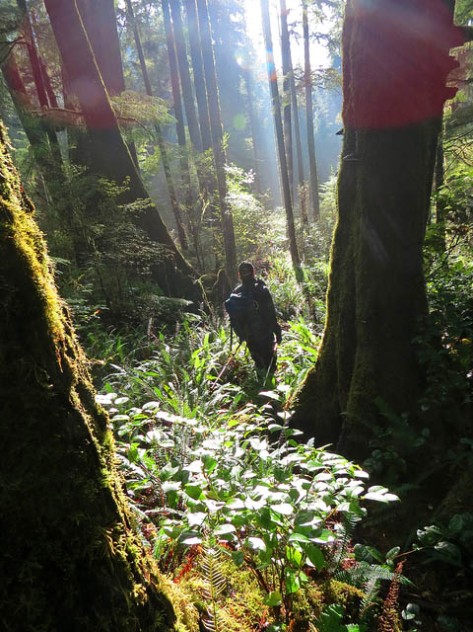It rests in a quiet clearing near Cheewhat Lake, within Vancouver Island’s Pacific Rim National Park Reserve. Once I had finally managed to visit this ancient tree in 2012, it had already occupied my mind for nearly twenty years! It was known as the second largest western red cedar for quite some time, but in 2016, that was to change. That was when Olympic National Park’s Quinault Cedar, in Washington, was damaged irreparably in a devastating windstorm. The Cheewhat tree, after that disaster, became the world champion.

The tree was rediscovered in 1988 by the late Maywell Wickheim, a resident of Sooke, British Columbia, and one of Canada’s most dedicated big tree hunters. I say rediscovered, because no doubt First Nations people had made its acquaintance before, as just downslope from this massive tree lie the remnants of a dugout canoe that was never quite finished. Wickheim, for his part, is said to have hinted about an even larger specimen in the general area, though if that is true, he took that secret to his grave. Regarding that topic, British Columbia Big Tree Committee member Will O’Connell and fellow tree enthusiast Eric Walton have come out with a six part series called Searching for Maywell’s Tree, which might interest you. Indeed, many aspiring tree enthusiasts are still searching this region of the west coast for the next big find. To those of us who scour the forests for big trees, that mere possibility evokes the same kind of zeal that drives people to find lost gold mines, albeit without the promise of great financial reward!

It takes more than a little preparation and plenty of driving on logging roads to reach a small roadside cairn on Rosander Main, and the winding trail that will lead youth the Cheewhat Cedar. Directions to the tree are relatively well known, and access has improved somewhat over the years. A vehicle in good condition with four decent tires and a sturdy spare at the ready are still strongly recommended, should you decide to make the trip. The trail itself, while not especially well marked, does have a well worn footbed that is reasonably simple to follow for experienced hikers.




As you draw closer to this giant, you’ll be truly inspired by the surrounding forest. The understory is very biodiverse, and in ideal conditions the natural light through the canopy is nothing less than enchanting. When you finally do stand before the Cheewhat Lake Cedar, it makes a momentous impression, to put it mildly. Its diameter at breast height is recorded as 5.86 metres (19.5 feet) in width. The tree is thought to be as old as 2500 years by some, though there have been disagreements regarding its age. It has endured for many centuries, without question, and is truly a national treasure. Should you be fortunate enough to visit, be sure to treat it with the utmost respect, as trees like these are both precious and irreplaceable.







Undoubtedly, much of British Columbia’s ancient forests have sadly disappeared into the annals of history, alive only in archival photos and tales of the past. The time has come to protect those that remain, and continue the transition to harvesting second growth timber sources. The sobering reality is that the future of our wilderness depends entirely on our will to preserve it. The Cheewhat Cedar is a symbol of hope, but more than that, its very existence gives us the chance to appreciate what nature can accomplish when left to its own devices. May it continue to stand for many more centuries!



Great post of the Cheewhat Cedar!! My brother and I bushwhacked to it in September 2017. We in Oregon claim the co-world champion western redcedar near Arcadia Beach on our north coast. Please keep this location confidential!
LikeLike
I remember that, Darvel. Some day I must visit that tree in Oregon!
LikeLike
Let me know when you are heading “down” to see it, and I’ll send you a map of the exact location. Cheers, Darvel
LikeLiked by 1 person
I will. Better still, I’d love to visit it with you and your brother!
LikeLike
Darryl and I will get in touch with you before our next big-tree hunting trip to B.C. He’s now writing a book about our adventures and discoveries,
LikeLike
We went to visit yesterday. It will probably be many many years until we go back but I’d love more info about the dugout canoe. Is it viewable? Love your post!
LikeLiked by 1 person
Glad you enjoyed the post. The canoe can be seen if you explore the area, but out of respect to the First Nations people of the region I chose not to take a photograph. Not sure if others have ever disclosed the information but even twenty years ago its presence was known
LikeLike